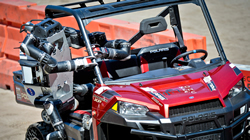Why Robots and Humans Struggled with DARPA's Challenge
 Will Knight for MIT Technology Review: When some of the world’s most advanced rescue robots are foiled by nothing more complex than a doorknob, you get a good sense of the challenge of making our homes and workplaces more automated.
Will Knight for MIT Technology Review: When some of the world’s most advanced rescue robots are foiled by nothing more complex than a doorknob, you get a good sense of the challenge of making our homes and workplaces more automated.At the DARPA Robotics Challenge, a contest held over the weekend in California, two dozen extremely sophisticated robots did their best to perform a series of tasks on an outdoor course, including turning a valve, climbing some steps, and opening a door (see “A Transformer Wins DARPA’s $2 Million Robotics Challenge”). Although a couple of robots managed to complete the course, others grasped thin air, walked into walls, or simply toppled over as if overcome with the sheer impossibility of it all. At the same time, efforts by human controllers to help the robots through their tasks may offer clues as to how human-machine collaboration could be deployed in various other settings.
“I think this is an opportunity for everybody to see how hard robotics really is,” says Mark Raibert, founder of Boston Dynamics, now owned by Google, which produced an extremely sophisticated humanoid robot called Atlas. Cont'd...
Comments (0)
This post does not have any comments. Be the first to leave a comment below.
Featured Product

Supply Chain Management by Elisa IndustrIQ
Elisa IndustrIQ's Supply Chain Management (SCM) solution is designed to enhance productivity, efficiency, and effectiveness throughout the entire supply chain. This advanced solution focuses on improving flexibility and responsiveness in both planning and operation execution, crucial for adapting to rapidly evolving markets. Our solution facilitates business growth by offering end-to-end visibility, essential for efficiently managing and streamlining supply chains. Key features include AI-powered demand forecasting, automated quoting and purchasing, intelligent replanning capabilities, structured collaboration tools, and direct supplier integration. These features can be tailored to align with your business and financial objectives, adding a strategic dimension to sales and operations planning and execution. The solution is designed to meet the manufacturing industry's needs for speed, resilience, and efficiency, primarily through innovative approaches to reduce business friction.
